Complete Classical Piano Music
- p.1 (Aa - Al)
- p.2 (Al - At)
- p.3 (At - Ba)
- p.4 (Ba - Ba)
- p.5 (Ba - Ba)
- p.6 (Ba - Ba)
- p.7 (Ba - Ba)
- p.8 (Ba - Ba)
- p.9 (Ba - Ba)
- p.10 (Ba - Ba)
- p.11 (Ba - Be)
- p.12 (Be - Be)
- p.13 (Be - Be)
- p.14 (Be - Be)
- p.15 (Be - Be)
- p.16 (Be - Be)
- p.17 (Be - Be)
- p.18 (Be - Bo)
- p.19 (Bo - Br)
- p.20 (Br - Br)
- p.21 (Br - Bu)
- p.22 (Bu - Ch)
- p.23 (Ch - Ch)
- p.24 (Ch - Ch)
- p.25 (Ch - Ch)
- p.26 (Ch - Ch)
- p.27 (Ch - Cl)
- p.28 (Cl - Co)
- p.29 (Co - Cz)
- p.30 (Cz - Da)
- p.31 (Da - De)
- p.32 (De - De)
- p.33 (De - De)
- p.34 (De - Du)
- p.35 (Du - En)
- p.36 (En - Fo)
- p.37 (Fr - Ge)
- p.38 (Gi - Gr)
- p.39 (Gr - Gr)
- p.40 (Gr - Gu)
- p.41 (Gu - Ha)
- p.42 (Ha - Ha)
- p.43 (Ha - Ha)
- p.44 (Ha - He)
- p.45 (He - Hy)
- p.46 (Ia - Jo)
- p.47 (Jo - Ka)
- p.48 (Ka - Ko)
- p.49 (Ko - La)
- p.50 (La - Li)
- p.51 (Li - Li)
- p.52 (Li - Li)
- p.53 (Li - Ma)
- p.54 (Ma - Mc)
- p.55 (Mc - Me)
- p.56 (Me - Mo)
- p.57 (Mo - Mo)
- p.58 (Mo - Mo)
- p.59 (Mo - Mo)
- p.60 (Mo - Na)
- p.61 (Ne - Pa)
- p.62 (Pa - Pl)
- p.63 (Pl - Pr)
- p.64 (Pr - Ra)
- p.65 (Ra - Ra)
- p.66 (Ra - Ra)
- p.67 (Ra - Ri)
- p.68 (Ri - Ro)
- p.69 (Ro - Sa)
- p.70 (Sa - Sc)
- p.71 (Sc - Sc)
- p.72 (Sc - Sc)
- p.73 (Sc - Sc)
- p.74 (Sc - Sc)
- p.75 (Sc - Sc)
- p.76 (Sc - Sc)
- p.77 (Sc - Sh)
- p.78 (Sh - Sn)
- p.79 (Sn - St)
- p.80 (St - Sz)
- p.81 (Ta - Tc)
- p.82 (Tc - Tu)
- p.83 (Tu - Va)
- p.84 (Va - Va)
- p.85 (Va - Va)
- p.86 (Va - Va)
- p.87 (Va - Va)
- p.88 (Va - Va)
- p.89 (Va - Va)
- p.90 (Va - Va)
- p.91 (Va - Va)
- p.92 (Va - Va)
- p.93 (Va - Va)
- p.94 (Va - Va)
- p.95 (Va - Va)
- p.96 (Va - Va)
- p.97 (Va - Vi)
- p.98 (Vi - We)
- p.99 (We - Za)
- p.100 (Za - Zy)
- Next >
-
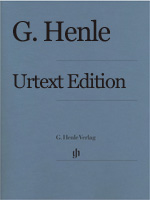
-
Haydn, Franz Joseph
Dances & Marches
G. Henle URTEXT edition.
Category: Piano Solos
Item: 025148
Grade:
Price: $19.95
Availability: Ships in 6 to 9 Days - View Shopping Cart
-
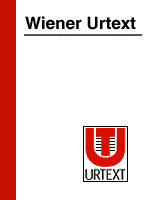
-
Haydn, Franz Joseph
Easiest Sonatas, Hob.XVI:4,7,8 & 9 (Landon/Leisinger)
Category: Piano Composer Folios
Item: 079266
Grade:
Price: $9.95
Availability: Ships in 6 to 9 Days - View Shopping Cart
-

-
Haydn, Franz Joseph
Easy Sonatas (6) (Snell)
Category: Piano Composer Folios
Item: 027412
Grade:
Price: $3.95
Availability: Ships in 10 to 14 Days - View Shopping Cart
-
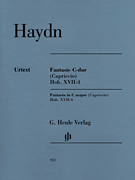
-
Haydn, Franz Joseph
Fantasia in C (Capriccio), Hob.XVII:4 (Gerlach/Schornstein)
Classical. When he switched from the harpsichord to the fortepiano in the 1780s, Joseph Haydn found he had a rich palette of sound colors and dynamic variations at his disposal, and he employed them enthusiastically in his C-major Fantasy. This piano piece, composed in early 1789 in a "whimsical hour," was intended by Haydn to meet with approval from "both connoisseurs and amateurs" - not least because it is "not too difficult." Christine Schornsheim provides historically accurate fingerings. Thi...
Read More
Category: Piano Solos
Item: 114422
Grade:
Price: $11.95
Availability: Usually Ships in 24 Hours - View Shopping Cart
-
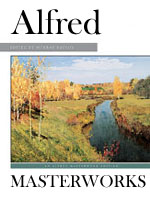
-
Haydn, Franz Joseph
Fantasia in C, Hob.XVII:4 (Hinson)
Category: Piano Solos
Item: 026343
Grade:
Price: $2.95
Availability: Ships in 6 to 9 Days - View Shopping Cart
-
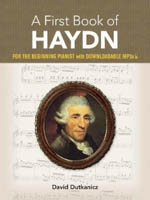
-
Haydn, Franz Joseph
First Book of Haydn, A (Dutkanicz)
Category: Piano Composer Folios
Item: 124307
Grade:
Price: $7.95
Availability: Ships in 10 to 15 Days - View Shopping Cart
-
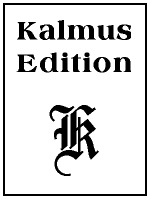
-
Haydn, Franz Joseph
German Dances (10)
Category: Piano Composer Folios
Item: 014983
Grade:
Price: $7.95
Availability: Ships in 10 to 15 Days - View Shopping Cart
-

-
Haydn, Franz Joseph
Great Piano Works of
Category: Piano Composer Folios
Item: 027864
Grade:
Price: $9.95
Availability: Ships in 6 to 9 Days - View Shopping Cart
-

-
Haydn, Franz Joseph
Gypsy Rondo, Hob.XV-25:3 (Hinson)
Category: Piano Solos
Item: 032539
Grade:
Price: $3.50
Availability: Ships in 6 to 9 Days - View Shopping Cart
-

-
Haydn, Franz Joseph
Haydn-Schaum, v.1 (Schaum)
Category: Piano Composer Folios
Item: 049896
Grade: Grade 3 - Early Intermediate
Price: $5.95
Availability: Ships in 6 to 9 Days - View Shopping Cart
-

-
Haydn, Franz Joseph
Haydn-Schaum, v.2 (Schaum)
Category: Piano Composer Folios
Item: 049897
Grade: Grade 4 - Intermediate
Price: $5.95
Availability: Ships in 6 to 9 Days - View Shopping Cart
-
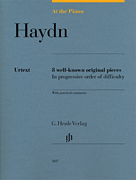
-
Haydn, Franz Joseph
Haydn: At the Piano (Hewig-Troescher)
Category: Piano Composer Folios
Item: 115362
Grade:
Price: $19.95
Availability: Usually Ships in 24 Hours - View Shopping Cart
-

-
Haydn, Franz Joseph
Introduction to his Keyboad Works (Luktenberg)
Category: Piano Composer Folios
Item: 004894
Grade:
Price: $8.95
Availability: Ships in 6 to 9 Days - View Shopping Cart
-

-
Haydn, Franz Joseph
Little Early Sonatas (9)
G. Henle URTEXT edition.
Category: Piano Composer Folios
Item: 032506
Grade:
Price: $18.95
Availability: Ships in 6 to 9 Days - View Shopping Cart
-

-
Haydn, Franz Joseph
Piano Compositions (Tucker)
Category: Piano Composer Folios
Item: 017643
Grade:
Price: $5.95
Availability: Ships in 6 to 9 Days - View Shopping Cart
-

-
Haydn, Franz Joseph
Piano Pieces (Eibner/Jarecki)
Includes: Capriccio in G; Fantasia in C; 20 Variations in G; Arietta no 1; Arietta no 2; 6 Easy Variations; Andante con variazioni; Variations on Gott erhalte; Adagio in F; Adagio in G; Allegretto in G after a piece for Flute Clock; Allegretto in G from String Quartet Hob III:41; Il maestro e lo scolare, Sonata a quattro mani.
Category: Piano Composer Folios
Item: 073947
Grade:
Price: $23.97
Availability: Ships in 6 to 9 Days - View Shopping Cart
-

-
Haydn, Franz Joseph
Piano Pieces & Variations (Gerlach/Theopold)
G. Henle URTEXT edition
Category: Piano Composer Folios
Item: 013834
Grade:
Price: $24.95
Availability: Ships in 6 to 9 Days - View Shopping Cart
-

-
Haydn, Franz Joseph
Selected Sonatas, v.1
G. Henle URTEXT edition
Category: Piano Composer Folios
Item: 012629
Grade:
Price: $39.95
Availability: Ships in 6 to 9 Days - View Shopping Cart
-

-
Haydn, Franz Joseph
Selected Sonatas, v.2
G. Henle URTEXT edition
Category: Piano Composer Folios
Item: 003348
Grade:
Price: $39.95
Availability: Ships in 6 to 9 Days - View Shopping Cart
-
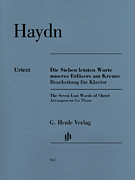
-
Haydn, Franz Joseph
Seven Last Words of Christ, The (Scheideler/Schilde)
Baroque. Written for orchestra in 1786, Haydn also made a version of The Seven Last Words of Christ for string quartet and later adapted the work as an oratorio. Although he did not write it, Haydn praised the keyboard arrangement, now available in this Urtext edition.
Category: Piano Solos
Item: 083893
Grade:
Price: $29.95
Availability: Ships in 6 to 9 Days - View Shopping Cart
-
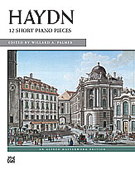
-
Haydn, Franz Joseph
Short Pieces (12)
Brought together in the early part of the 19th century, some of the pieces in this collection are transcriptions of instrumental works. However, these masterfully constructed miniatures are well suited to keyboard performance and are characteristic of Haydn's humor, tenderness, charm and passion. The selections provide intermediate pianists with a wealth of musical ideas and harmonic invention, and are similar in difficulty to Haydn's Sonatinas. - the publisher (thematic index) ...
Read More
Category: Piano Composer Folios
Item: 012528
Grade:
Price: $6.99
Availability: Usually Ships in 24 Hours - View Shopping Cart
-
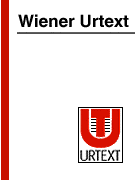
-
Haydn, Franz Joseph
Sonata in A, Hob.XVI:26 (Landon et al)
Category: Piano Solos
Item: 104542
Grade:
Price: $9.95
Availability: Ships in 6 to 9 Days - View Shopping Cart
-

-
Haydn, Franz Joseph
Sonata in C, Hob.XVI:35
Category: Piano Solos
Item: 019803
Grade:
Price: $3.95
Availability: Ships in 6 to 9 Days - View Shopping Cart
-

-
Haydn, Franz Joseph
Sonata in C, Hob.XVI:35
G. Henle URTEXT edition
Category: Piano Solos
Item: 013820
Grade:
Price: $8.95
Availability: Ships in 6 to 9 Days - View Shopping Cart
-
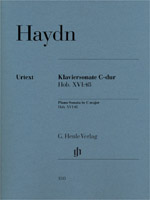
-
Haydn, Franz Joseph
Sonata in C, Hob.XVI:48 (Feder/Schloen/Anderszewski)
Classical. This Haydn sonata has previously not been available in the Henle catalogue as an individual Urtext edition. Nevertheless, it numbers among Haydn's famous piano works. It was written in 1789 (thus making it one of the "late sonatas") for the Leipzig publisher Christoph Gottlob Breitkopf. Its two-movement structure fathoms the entire spectrum of Haydn's musical language: from the brooding-improvisational first movement to the sparkling, humorous Finale. Haydn exploits here the full range...
Read More
Category: Piano Solos
Item: 132128
Grade: Advanced
Price: $11.95
Availability: Usually Ships in 24 Hours - View Shopping Cart
-
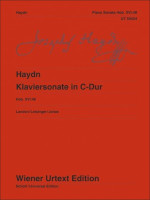
-
Haydn, Franz Joseph
Sonata in C, Hob.XVI:48 (Landon/Leisinger/Jonas)
Category: Piano Solos
Item: 125029
Grade:
Price: $8.95
Availability: Usually Ships in 24 Hours - View Shopping Cart
-
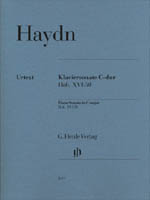
-
Haydn, Franz Joseph
Sonata in C, Hob.XVI:50 (Feder)
Category: Piano Solos
Item: 137811
Grade: Grade 6 - Advanced
Price: $11.95
Availability: Usually Ships in 24 Hours - View Shopping Cart
-
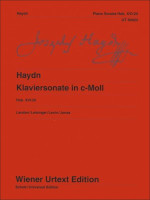
-
Haydn, Franz Joseph
Sonata in Cm, Hob.XVI:20 (Landon/Leisinger/Levin/Jonas)
Category: Piano Solos
Item: 125031
Grade:
Price: $8.95
Availability: Ships in 6 to 9 Days - View Shopping Cart
-

-
Haydn, Franz Joseph
Sonata in D, Hob.XVI:37 (Landon/Leisinger et al)
Category: Piano Solos
Item: 095211
Grade:
Price: $8.95
Availability: Ships in 6 to 9 Days - View Shopping Cart
-

-
Haydn, Franz Joseph
Sonata in D, Hob.XVI:37
G. Henle URTEXT edition (sample page)
(sample page)
Category: Piano Solos
Item: 009547
Grade:
Price: $8.95
Availability: Ships in 6 to 9 Days - View Shopping Cart
-

-
Haydn, Franz Joseph
Sonata in D, Hob.XVI:37
Category: Piano Solos
Item: 019802
Grade:
Price: $3.50
Availability: Ships in 6 to 9 Days - View Shopping Cart
-
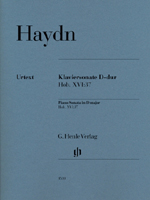
-
Haydn, Franz Joseph
Sonata in D, Hob.XVI:37 (Feder)
Category: Piano Solos
Item: 133268
Grade:
Price: $9.95
Availability: Usually Ships in 24 Hours - View Shopping Cart
-

-
Haydn, Franz Joseph
Sonata in E, Hob XVI: 31
The two Piano Sonatas in G major (Hob. XVI:6) and E major (Hob. XVI:31) occupy a special place in Haydn's sonata output. The G major sonata is one of the most expressive of the composer's early piano sonatas, while the E major sonata seems to have becomea very popular work immediately after it was written. Their moderate technical demands make them particularly welcome teaching materials. Their fresh musical approach and contrasting variety of expression make them equally worthwhile repertoire pi...
Read More
Category: Piano Solos
Item: 134946
Grade: Grade 5 - Early Advanced
Price: $9.95
Availability: Usually Ships in 24 Hours - View Shopping Cart
-

-
Haydn, Franz Joseph
Sonata in Eb, Hob.XVI:52 (Feder/Theopold)
Category: Piano Solos
Item: 112167
Grade:
Price: $10.95
Availability: Ships in 10 to 15 Days - View Shopping Cart
-
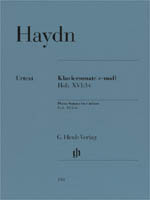
-
Haydn, Franz Joseph
Sonata in Em, Hob.XVI:34 (Feder)
Only a few of Haydn's piano sonatas are in the minor mode, and they are all sombre and defiant in tone. This famous sonata in e minor opens with an impatient, throbbing motif in what is surely one of the most passionate movements by this Viennese master.The middle movement in G major, by contrast, transports us into a different world that is flooded with light. The finale sets off in a restless manner, and its alternation of major and minor provides a cheerfully ironic close to the work. You can ...
Read More
Category: Piano Solos
Item: 134644
Grade:
Price: $9.95
Availability: Ships in 10 to 15 Days - View Shopping Cart
-

-
Haydn, Franz Joseph
Sonata in Em, Hob.XVI:34 (Feder/Theopold)
Classical. With this E minor piano sonata, Classical-era composer Haydn created a work that displays positively romantic traits. Agitation and excitement are expressed in the main ideas of the first movement, while contrasting seriousness and cheerfulness come into sharp relief in the finale. Of Haydn's sixty-or-so piano sonatas, the E minor Sonata numbers are among those of moderate difficulty. Our editor, Georg Feder, is considered one of the most important Haydn researchers of this time. Conse...
Read More
Category: Piano Solos
Item: 006530
Grade:
Price: $8.95
Availability: Ships in 6 to 9 Days - View Shopping Cart
-
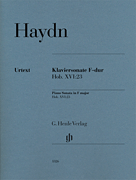
-
Haydn, Franz Joseph
Sonata in F, Hob.XVI:23 (Feder)
Category: Piano Solos
Item: 112529
Grade:
Price: $9.95
Availability: Ships in 10 to 15 Days - View Shopping Cart
-

-
Haydn, Franz Joseph
Sonata in G, Hob XVI: 6
The two Piano Sonatas in G major (Hob. XVI:6) and E major (Hob. XVI:31) occupy a special place in Haydn's sonata output. The G major sonata is one of the most expressive of the composer's early piano sonatas, while the E major sonata seems to have becomea very popular work immediately after it was written. Their moderate technical demands make them particularly welcome teaching materials. Their fresh musical approach and contrasting variety of expression make them equally worthwhile repertoire pi...
Read More
Category: Piano Solos
Item: 134940
Grade: Grade 5 - Early Advanced
Price: $9.95
Availability: Usually Ships in 24 Hours - View Shopping Cart
-

-
Haydn, Franz Joseph
Sonata in G, Hob.XVI:40
G. Henle URTEXT edition.
Category: Piano Solos
Item: 013874
Grade:
Price: $11.95
Availability: Ships in 6 to 9 Days - View Shopping Cart
-
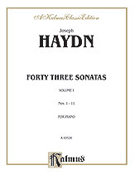
-
Haydn, Franz Joseph
Sonatas (43), v.1
Classical. Includes: • Sonata No. 1 in Eb • Sonata No. 2 in Em • Sonata No. 3 in Eb • Sonata No. 4 in Gm • Sonata No. 5 in C • Sonata No. 6 in C#m • Sonata No. 7 in D • Sonata No. 8 in Ab • Sonata No. 9 in D • Sonata No. 10 in G • Sonata No. 11 in G (thematic index) ...
Read More
Category: Piano Composer Folios
Item: 011397
Grade:
Price: $14.95
Availability: Ships in 6 to 9 Days - View Shopping Cart
-

-
Haydn, Franz Joseph
Sonatas (43), v.2
Category: Piano Composer Folios
Item: 003609
Grade:
Price: $12.95
Availability: Ships in 6 to 9 Days - View Shopping Cart
-

-
Haydn, Franz Joseph
Sonatas (43), v.3
Category: Piano Composer Folios
Item: 003610
Grade:
Price: $12.95
Availability: Ships in 6 to 9 Days - View Shopping Cart
-

-
Haydn, Franz Joseph
Sonatas (43), v.4
Category: Piano Composer Folios
Item: 003631
Grade:
Price: $9.95
Availability: Ships in 6 to 9 Days - View Shopping Cart
-
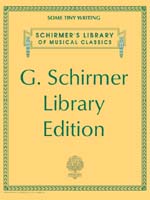
-
Haydn, Franz Joseph
Sonatas (52), v.1
Category: Piano Composer Folios
Item: 019397
Grade:
Price: $18.99
Availability: Ships in 6 to 9 Days - View Shopping Cart
-

-
Haydn, Franz Joseph
Sonatas (52), v.2
Category: Piano Composer Folios
Item: 019398
Grade:
Price: $19.99
Availability: Ships in 6 to 9 Days - View Shopping Cart
-
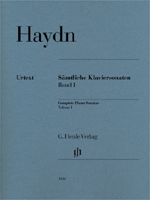
-
Haydn, Franz Joseph
Sonatas Complete, v.1 (Feder/Raab/Schloen)
Baroque. 55 internationally celebrated pianists were invited to adopt one Haydn piano sonata each and provide it with their personal fingerings - a "who's who" on the contemporary piano scene. G. Henle Publishers now presents this classic, revised and with a new look, to all pianists in the certainty that Haydn's sonatas will further cement their place in the world of music. Volume I contains Haydn's early sonatas, very much still born of the spirit of the early Classical period: catchy music, fu...
Read More
Category: Piano Composer Folios
Item: 132486
Grade: Advanced
Price: $45.95
Availability: Usually Ships in 24 Hours - View Shopping Cart
-
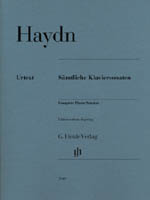
-
Haydn, Franz Joseph
Sonatas Complete, v.1 [without fingering] (Feder/Raab/Schloen)
Henle Urtext Edition in 3 volumes: 132758, 132759, 132760. The revision of the three-volume edition of Haydn's piano sonatas also appears in a version without fingerings. Whoever wishes to study the Classical sonata canon in "pure" Urtext, free from added fingering suggestions, will now also find these in the Henle catalogue. Volume I contains Haydn's early sonatas, very much still born of the spirit of the early Classical period: catchy music, fun to play, often at a moderate level of difficult...
Read More
Category: Piano Composer Folios
Item: 132758
Grade:
Price: $49.95
Availability: Usually Ships in 24 Hours - View Shopping Cart
-
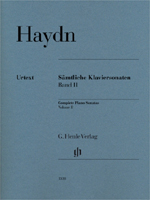
-
Haydn, Franz Joseph
Sonatas Complete, v.2 (Feder/Raab/Schloen)
Baroque. 55 internationally celebrated pianists were invited to adopt one Haydn piano sonata each and provide it with their personal fingerings - a "who's who" on the contemporary piano scene. G. Henle Publishers now presents this classic, revised and with a new look, to all pianists in the certainty that Haydn's sonatas will further cement their place in the world of music. Volume II contains three sets of six sonatas, each more famous than the last and all replete with delightful thematic ideas...
Read More
Category: Piano Composer Folios
Item: 132487
Grade: Advanced
Price: $49.95
Availability: Ships in 10 to 15 Days - View Shopping Cart
-

-
Haydn, Franz Joseph
Sonatas Complete, v.2 [without fingering] (Feder/Schloen)
Henle Urtext Edition in 3 volumes: 132758, 132759, 132760. The revision of the three-volume edition of Haydn's piano sonatas also appears in a version without fingerings. Whoever wishes to study the Classical sonata canon in "pure" Urtext, free from added fingering suggestions, will now also find these in the Henle catalogue. Volume I contains Haydn's early sonatas, very much still born of the spirit of the early Classical period: catchy music, fun to play, often at a moderate level of difficult...
Read More
Category: Piano Composer Folios
Item: 132759
Grade:
Price: $49.95
Availability: Usually Ships in 24 Hours - View Shopping Cart
-
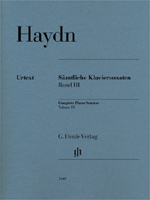
-
Haydn, Franz Joseph
Sonatas Complete, v.3 (Feder/Raab/Schloen)
Baroque. 55 internationally celebrated pianists were invited to adopt one Haydn piano sonata each and provide it with their personal fingerings - a "who's who" on the contemporary piano scene. G. Henle Publishers now presents this classic, revised and with a new look, to all pianists in the certainty that Haydn's sonatas will further cement their place in the world of music. Volume III offers the crowning achievement of Haydn's sonata-writing with these late works, including famous works such as ...
Read More
Category: Piano Composer Folios
Item: 132488
Grade: Advanced
Price: $45.95
Availability: Ships in 10 to 15 Days - View Shopping Cart
- p.1 (Aa - Al)
- p.2 (Al - At)
- p.3 (At - Ba)
- p.4 (Ba - Ba)
- p.5 (Ba - Ba)
- p.6 (Ba - Ba)
- p.7 (Ba - Ba)
- p.8 (Ba - Ba)
- p.9 (Ba - Ba)
- p.10 (Ba - Ba)
- p.11 (Ba - Be)
- p.12 (Be - Be)
- p.13 (Be - Be)
- p.14 (Be - Be)
- p.15 (Be - Be)
- p.16 (Be - Be)
- p.17 (Be - Be)
- p.18 (Be - Bo)
- p.19 (Bo - Br)
- p.20 (Br - Br)
- p.21 (Br - Bu)
- p.22 (Bu - Ch)
- p.23 (Ch - Ch)
- p.24 (Ch - Ch)
- p.25 (Ch - Ch)
- p.26 (Ch - Ch)
- p.27 (Ch - Cl)
- p.28 (Cl - Co)
- p.29 (Co - Cz)
- p.30 (Cz - Da)
- p.31 (Da - De)
- p.32 (De - De)
- p.33 (De - De)
- p.34 (De - Du)
- p.35 (Du - En)
- p.36 (En - Fo)
- p.37 (Fr - Ge)
- p.38 (Gi - Gr)
- p.39 (Gr - Gr)
- p.40 (Gr - Gu)
- p.41 (Gu - Ha)
- p.42 (Ha - Ha)
- p.43 (Ha - Ha)
- p.44 (Ha - He)
- p.45 (He - Hy)
- p.46 (Ia - Jo)
- p.47 (Jo - Ka)
- p.48 (Ka - Ko)
- p.49 (Ko - La)
- p.50 (La - Li)
- p.51 (Li - Li)
- p.52 (Li - Li)
- p.53 (Li - Ma)
- p.54 (Ma - Mc)
- p.55 (Mc - Me)
- p.56 (Me - Mo)
- p.57 (Mo - Mo)
- p.58 (Mo - Mo)
- p.59 (Mo - Mo)
- p.60 (Mo - Na)
- p.61 (Ne - Pa)
- p.62 (Pa - Pl)
- p.63 (Pl - Pr)
- p.64 (Pr - Ra)
- p.65 (Ra - Ra)
- p.66 (Ra - Ra)
- p.67 (Ra - Ri)
- p.68 (Ri - Ro)
- p.69 (Ro - Sa)
- p.70 (Sa - Sc)
- p.71 (Sc - Sc)
- p.72 (Sc - Sc)
- p.73 (Sc - Sc)
- p.74 (Sc - Sc)
- p.75 (Sc - Sc)
- p.76 (Sc - Sc)
- p.77 (Sc - Sh)
- p.78 (Sh - Sn)
- p.79 (Sn - St)
- p.80 (St - Sz)
- p.81 (Ta - Tc)
- p.82 (Tc - Tu)
- p.83 (Tu - Va)
- p.84 (Va - Va)
- p.85 (Va - Va)
- p.86 (Va - Va)
- p.87 (Va - Va)
- p.88 (Va - Va)
- p.89 (Va - Va)
- p.90 (Va - Va)
- p.91 (Va - Va)
- p.92 (Va - Va)
- p.93 (Va - Va)
- p.94 (Va - Va)
- p.95 (Va - Va)
- p.96 (Va - Va)
- p.97 (Va - Vi)
- p.98 (Vi - We)
- p.99 (We - Za)
- p.100 (Za - Zy)
- Next >
More Options
- Use our Custom Order Page to special order items you can't find.
- Use our Catalog Order Page to order items from a printed catalog, or if you already know our catalog number for the item(s) you're interested in.
- And as always, feel free to E-mail us with your questions!
